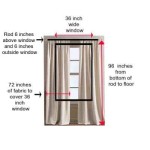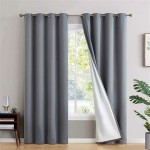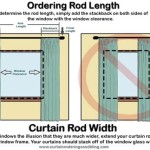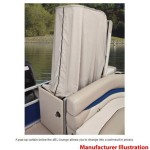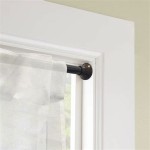Valance Curtains for Bay Windows: Enhancing Style and Functionality
Bay windows, with their projecting structure and multiple panes of glass, offer a unique architectural feature that enhances natural light and expands interior space. However, their distinctive shape and size often pose a challenge when it comes to window treatments. Valance curtains, a decorative window covering that adorns the top portion of the window, provide an elegant and versatile solution for bay windows. This article explores the various aspects of valance curtains for bay windows, including their styles, benefits, considerations for selection, and installation tips.
Defining Valance Curtains and Their Significance
Valance curtains are short draperies that are installed across the top of a window, concealing hardware or adding a decorative touch. Unlike full-length curtains, valances do not extend to the floor. They primarily serve an aesthetic purpose, framing the window and providing a visual balance to the room. For bay windows, which can sometimes appear bare or disproportionate without proper dressing, valances can soften the lines and create a more cohesive and inviting atmosphere.
The history of valances can be traced back centuries, with early examples found in European castles and grand estates. Initially, they served a practical purpose by preventing drafts and protecting valuable fabrics from sunlight. Over time, valances evolved into a decorative element, reflecting changing styles and tastes. Today, valances are available in a wide range of designs, fabrics, and colors, offering homeowners endless possibilities for customizing their window treatments.
Valances can be used alone or in combination with other window treatments such as blinds, shades, or full-length curtains. This versatility allows for a layered look that provides both privacy and light control. In the context of bay windows, layering is particularly useful, as it allows for independent operation of the underlying treatments while the valance maintains a consistent aesthetic.
Exploring Different Styles of Valance Curtains for Bay Windows
The style of valance chosen for a bay window significantly impacts the overall look and feel of the room. The following are some common valance styles suitable for bay windows:
Swag Valances: Swag valances are characterized by their cascading, draped fabric that hangs in a graceful curve. They often feature multiple swags, creating a soft and romantic look. Swag valances work well in formal living rooms or bedrooms, adding a touch of elegance and sophistication. The number of swags can be adjusted to fit the size and shape of the bay window.
Scarf Valances: Scarf valances consist of a single piece of fabric draped over a rod or decorative holders. They are known for their simplicity and versatility. Scarf valances can be arranged in various ways, creating different levels of fullness and asymmetry. They are a good choice for those seeking a more casual and contemporary look.
Box Pleat Valances: Box pleat valances feature evenly spaced, structured pleats that create a tailored and sophisticated appearance. They are often used in formal settings or when a more structured look is desired. Box pleat valances require precise measurements and careful construction to ensure a uniform and balanced appearance.
Gathered Valances: Gathered valances are created by gathering the fabric along a rod or heading tape, creating a soft and flowing look. They are a versatile option that can be adapted to various decor styles. Gathered valances are relatively easy to construct and can be customized with different fabric types and embellishments.
Rod Pocket Valances: Rod pocket valances have a sewn-in pocket at the top that allows them to be easily slid onto a curtain rod. They are a simple and affordable option that works well in casual settings. Rod pocket valances can be gathered or pleated to create different levels of fullness.
Balloon Valances: Balloon valances are characterized by their poufy, rounded shape, created by gathering the fabric at the bottom. They are often used in nurseries or children's rooms, adding a touch of whimsy and charm. Balloon valances require careful shaping and construction to achieve the desired effect.
London Valances: London valances are similar to balloon valances but feature inverted pleats that create a more structured and tailored look. They are a sophisticated option that works well in formal living rooms or dining rooms.
Key Considerations for Selecting Valance Curtains for Bay Windows
Selecting the appropriate valance curtains for a bay window requires careful consideration of several factors. The following are some key aspects to consider:
Window Size and Shape: Bay windows come in various sizes and shapes, from shallow curves to more pronounced angles. The valance style and dimensions should be proportional to the window's size and complement its shape. For example, a shallow bay window might benefit from a simple scarf valance, while a larger, more angled bay window might require a more elaborate swag valance.
Room Decor and Style: The valance should complement the existing decor and style of the room. Consider the color palette, furniture style, and overall ambiance. A formal living room might benefit from a tailored box pleat valance, while a casual bedroom might be better suited to a gathered or rod pocket valance.
Fabric Choice: The fabric choice significantly impacts the look and feel of the valance. Consider the fabric's weight, texture, and color. Heavier fabrics, such as velvet or brocade, create a more formal and luxurious look, while lighter fabrics, such as cotton or linen, are better suited for casual settings. The color of the fabric should coordinate with the room's color scheme, either complementing or contrasting with the walls and other furnishings.
Light Control and Privacy: While valances primarily serve a decorative purpose, they can also contribute to light control and privacy. Darker fabrics will block more light, while lighter fabrics will allow more light to filter through. If privacy is a concern, consider layering the valance with blinds or shades.
Hardware Selection: The hardware used to hang the valance should be both functional and aesthetically pleasing. Consider the style and finish of the curtain rod, brackets, or decorative holders. The hardware should be strong enough to support the weight of the valance and should complement the overall design.
Budget: The cost of valance curtains can vary widely depending on the style, fabric, and hardware chosen. Establish a budget before beginning the selection process and prioritize the factors that are most important to you. Consider DIY options to save money or opt for simpler styles that require less fabric and labor.
Professional Installation vs. DIY: Installing valance curtains can be a relatively straightforward project for experienced DIYers. However, for complex designs or large bay windows, professional installation may be recommended. Professional installers have the expertise and tools to ensure a proper and secure installation, preventing damage to the window frame or wall.
Step-by-Step Guide to Installing Valance Curtains on Bay Windows
Installing valance curtains on bay windows requires careful planning and precise measurements. The following is a general guide to the installation process:
Measure the Bay Window: Accurately measure the width and height of each window pane in the bay window. Determine the desired length and projection of the valance. Consider the placement of any existing window treatments, such as blinds or shades.
Select the Appropriate Hardware: Choose the appropriate curtain rod, brackets, or decorative holders based on the valance style and weight. Ensure that the hardware is compatible with the window frame or wall material.
Mark the Mounting Locations: Using a level and measuring tape, mark the locations for the brackets or holders on the wall or window frame. Ensure that the markings are accurate and evenly spaced. For bay windows with angled panes, use a protractor to determine the correct angle for the brackets.
Install the Brackets or Holders: Drill pilot holes at the marked locations and install the brackets or holders using screws or anchors. Ensure that the brackets are securely attached to the wall or window frame. Use appropriate anchors for different wall materials, such as drywall, plaster, or brick.
Mount the Curtain Rod: Insert the curtain rod into the brackets or holders. Ensure that the rod is level and securely in place. Adjust the position of the brackets if necessary to achieve a level and balanced appearance.
Hang the Valance: Slide the valance onto the curtain rod or attach it to the decorative holders according to the manufacturer's instructions. Adjust the folds or pleats of the valance to achieve the desired look.
Make Final Adjustments: Step back and assess the overall appearance of the valance. Make any necessary adjustments to the position, folds, or pleats to achieve a balanced and aesthetically pleasing look. Ensure that the valance is securely attached and that all hardware is properly installed.
Valance curtains offer a versatile and stylish solution for enhancing bay windows. By carefully considering the style, fabric, hardware, and installation process, homeowners can create a window treatment that complements the room's decor and adds a touch of elegance and sophistication to their living space.

Valance Ideas For Bay Windows And Bow

How To Dress Bay Windows Parkway Window Works

Valance Ideas For Bay Windows And Bow

Faux Roman Shade Valance Ander Blue Or Graphite Grey Pewter White Print On Premium Cotton Linen Custom Made Fully Lined Curtains Etsy

Valance Ideas For Bay Windows And Bow
Pink Girl Living Room Modern Bay Window Cloth Curtain Tulle Valance Drape C1139

Bay Window Treatments Ideas Tips I Spiffy Spools

Valances For Kitchen Windows Bay Window Valance

Best Bay Window Curtain Ideas Decoholic

Valance Ideas For Bay Windows And Bow
See Also


